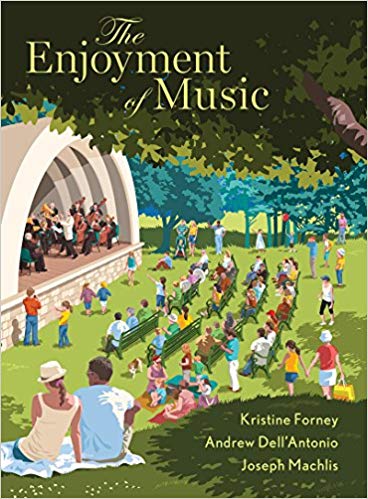Test Bank for The Enjoyment of Music (Thirteenth Edition) Thirteenth Edition

Product details:
- ISBN-10 : 0393639037
- ISBN-13 : 978-0393639032
- Author: Kristine Forney
For more than 60 years, this text has led the way in preparing students for a lifetime of listening to great music and understanding its cultural and historical context. The Thirteenth Edition builds on this foundation with NEW coverage of performance and musical style. NEW tools help students share their deepening listening skills and appreciation in writing and conversation.
Description:
Chapter 1 Melody: Musical Line
MULTIPLE CHOICE
- In determining pitch, what is meant by frequency?
| a. | how often the pitch is heard |
| b. | how fast the pitches are played |
| c. | the span between the highest and lowest notes |
| d. | the number of vibrations per second |
ANS: D DIF: Easy REF: 7 TOP: Melody
MSC: Remembering
- Musical sounds are represented by symbols called
| a. | pitches. | c. | notes. |
| b. | cues. | d. | amplitudes. |
ANS: C DIF: Easy REF: 7 TOP: Melody
MSC: Remembering
- By definition, a musical sound has
| a. | a perceivable pitch and a measurable frequency. |
| b. | a certain volume. |
| c. | a distinct timbre. |
| d. | all answers shown here. |
ANS: D DIF: Moderate REF: 7 TOP: Melody
MSC: Remembering
- A succession of single tones or pitches perceived as a unit is called a(n)
| a. | interval. | c. | harmony. |
| b. | melody. | d. | chord. |
ANS: B DIF: Easy REF: 7 TOP: Melody
MSC: Remembering
- The distance between the highest and lowest tones of a melody is called the
| a. | tempo. | c. | phrase. |
| b. | range. | d. | tonic. |
ANS: B DIF: Easy REF: 7 TOP: Melody
MSC: Remembering
- The distance between two pitches is called a(n)
| a. | interval. | c. | cadence. |
| b. | phrase. | d. | countermelody. |
ANS: A DIF: Easy REF: 8 TOP: Melody
MSC: Remembering
- Which term describes a melody that moves by small intervals?
| a. | consonant | c. | dissonant |
| b. | conjunct | d. | disjunct |
ANS: B DIF: Moderate REF: 8 TOP: Melody
MSC: Remembering
- A melody can be characterized by
| a. | its range. | c. | the way it moves. |
| b. | its shape. | d. | all answers shown here. |
ANS: D DIF: Moderate REF: 7–8 TOP: Melody
MSC: Analyzing
- Why is Beethoven’s Ode to Joy easy to sing?
| a. | It has a wide range. | c. | It has phrases of unequal lengths. |
| b. | It is conjunct. | d. | It has no cadences. |
ANS: B DIF: Difficult REF: 8 TOP: Melody
MSC: Analyzing
- A unit of meaning within the larger structure of a melody is called a
| a. | phrase. | c. | cadence. |
| b. | stanza. | d. | climax. |
ANS: A DIF: Moderate REF: 8 TOP: Melody
MSC: Remembering
- The resting place at the end of a phrase is called a
| a. | pause. | c. | cadence. |
| b. | period. | d. | comma. |
ANS: C DIF: Moderate REF: 8 TOP: Melody
MSC: Remembering
- Musical punctuation, which is similar to a comma or period in a sentence, is called a
| a. | cadence. | c. | chord. |
| b. | syncopation. | d. | scale. |
ANS: A DIF: Moderate REF: 8 TOP: Melody
MSC: Remembering
- The striking emotional effect created by the high point in a melodic line is called the
| a. | cadence. | c. | climax. |
| b. | countermelody. | d. | range. |
ANS: C DIF: Moderate REF: 9 TOP: Melody
MSC: Remembering
- A melody added to, or played against, another melody is called a
| a. | cadence. | c. | countermelody. |
| b. | phrase. | d. | tune. |
ANS: C DIF: Moderate REF: 9 TOP: Melody
MSC: Remembering
- A note designates frequency and
| a. | duration. | c. | timbre. |
| b. | volume. | d. | range. |
ANS: A DIF: Moderate REF: 7 TOP: Melody
MSC: Remembering
- In terms of a musical note, duration refers to
| a. | length of time. | c. | volume. |
| b. | timbre. | d. | None of the answers shown here. |
ANS: A DIF: Easy REF: 7 TOP: Melody
MSC: Remembering
- The distinct quality of a pitch is called
| a. | tone color or timbre. | c. | duration. |
| b. | volume. | d. | melody. |
ANS: A DIF: Moderate REF: 7 TOP: Melody
MSC: Applying
- Which term refers to the overall shape of a melody?
| a. | contour | c. | range |
| b. | interval | d. | cadence |
ANS: A DIF: Moderate REF: 8 TOP: Melody
MSC: Applying
- A melody that moves in large, disconnected intervals is described as
| a. | conjunct. | c. | pitchy. |
| b. | disjunct. | d. | easy to sing. |
ANS: B DIF: Difficult REF: 8 TOP: Melody
MSC: Analyzing
- In terms of text, this diagram, a b a b, refers to
| a. | the rhyme scheme. | c. | the melody. |
| b. | the overall form of the music. | d. | pitch. |
ANS: A DIF: Difficult REF: 9 TOP: Melody
MSC: Analyzing
TRUE/FALSE
- The length or size of a vibrating object has no effect on pitch.
ANS: F DIF: Easy REF: 7 TOP: Melody
MSC: Remembering
- A musical note is the symbolic representation of a sound with pitch and duration.
ANS: T DIF: Moderate REF: 7 TOP: Melody
MSC: Remembering
- Tone color is a property of pitch.
ANS: T DIF: Moderate REF: 7 TOP: Melody
MSC: Remembering
- The overall shape of a melody is called its range.
ANS: F DIF: Moderate REF: 7 TOP: Melody
MSC: Remembering
- Melodies that move principally by small, connected intervals are conjunct.
ANS: T DIF: Moderate REF: 8 TOP: Melody
MSC: Remembering
- Melodies that skip in disjointed intervals are disjunct.
ANS: T DIF: Moderate REF: 8 TOP: Melody
MSC: Remembering
- A phrase is a component unit of a melody.
ANS: T DIF: Easy REF: 8 TOP: Melody
MSC: Remembering
- The phrases in the tune Amazing Grace are of unequal length.
ANS: F DIF: Difficult REF: 9 TOP: Melody
MSC: Applying
- The melody of The Star-Spangled Banner is best described as conjunct.
ANS: F DIF: Moderate REF: 8 TOP: Melody
MSC: Applying
- The rhyme scheme of a poem is determined by the first word of each poetic line.
ANS: F DIF: Moderate REF: 9 TOP: Melody
MSC: Applying
- Volume refers to length of time, or duration, of a note.
ANS: F DIF: Easy REF: 7 TOP: Melody
MSC: Remembering
- The high point in a melody is known as its contour.
ANS: F DIF: Easy REF: 9 TOP: Melody
MSC: Remembering
- Stars and Stripes Forever includes a countermelody performed by the piccolos.
ANS: T DIF: Moderate REF: 9 TOP: Melody
MSC: Remembering
- A singer or instrumentalist will pause to draw a breath at a cadence.
ANS: T DIF: Moderate REF: 9 TOP: Melody
MSC: Remembering
- The component units of a melody have no relationship to sentence structure.
ANS: F DIF: Moderate REF: 8 TOP: Melody
MSC: Applying
ESSAY
- Describe the elements that contribute to the sound of a pitch.
ANS:
Answers will vary.
DIF: Moderate REF: 7–8 TOP: Melody MSC: Applying
- What are the features that give each melody a distinctive character?
ANS:
Answers will vary.
DIF: Moderate REF: 8–9 TOP: Melody MSC: Analyzing
- Compare the structure of a melody with the form of a sentence.
ANS:
Answers will vary.
DIF: Difficult REF: 8–9 TOP: Melody MSC: Analyzing
- Describe the differences between the melodies for Ode to Joy, Joy to the World, and The Star-Spangled Banner.
ANS:
Answers will vary.
DIF: Difficult REF: 8–9 TOP: Melody MSC: Analyzing
People also search:
the enjoyment of music thirteenth edition
the enjoyment of music thirteenth edition pdf free
the enjoyment of music thirteenth edition ebook
the enjoyment of music quizlet





